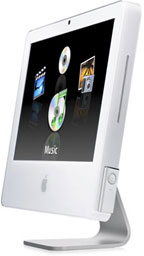Mac Musings
Is the New Edu-iMac a Good Value or Simply Too Compromised?
Daniel Knight - 2006.07.10 (updated)
Since publishing this article, Apple has suspended sale of the edu-iMac to individuals.
What do you think about the new education-only iMac?
That's the question of the day as educators contemplate whether to pick up the new low-cost iMac or its slightly more capable, more expensive 17" sibling.
Think Different
At first glance, you'd think they were the same machine. Both are housed in the same enclosure, run the same 1.83 GHz Intel Core Duo CPU, have built-in iSight, and support Apple's wireless remote (not included with the edu-iMac).
If you look at the specs, you'll see some differences. An 80 GB hard drive instead of 160 GB, a Combo drive instead of a SuperDrive, and no Bluetooth. But you save US$300.
But there is one more difference: Where the older iMac Core Duo has ATI Radeon X1600 with 128 MB of dedicated memory, the edu-iMac has Intel GMA 950 graphics that uses 80 MB of system memory.
How Much Different?
For the typical user, there probably won't be much difference between the two iMacs in daily use. You'll run out of free RAM a bit sooner, but that's about it. And if you take our advice of putting at least 1 GB in either model (to improve Rosetta performance), that won't be such a big issue.
Where you will see a significant difference is 3D gaming, so if you're a Quake, Doom, or World of Warcraft fan, you'll want to know how the video compares between the two iMacs. Thankfully our friends at Bare Feats have already done that work - well, sort of.
 Bare Feats has compared the MacBook,
which has the same Intel 950 GMA processor as the edu-iMac, to the
15" MacBook Pro, which has the same ATI Radeon X1600 graphics as
the regular iMac.
Bare Feats has compared the MacBook,
which has the same Intel 950 GMA processor as the edu-iMac, to the
15" MacBook Pro, which has the same ATI Radeon X1600 graphics as
the regular iMac.
Their findings at 1024 x 768:
- Quake 4, 11 fps for the Intel graphics vs. 48 for ATI.
- Doom 3, 9 fps vs. 44.
- Unreal Tournament 2004 flyby, 20 fps vs. 86
- Unreal Tournament 2004 botmatch, 13 fps vs. 54
- World of Warcraft, 12 fps vs. 16
You can check out all the details at Bare Feats, but it's pretty obvious that for serious 3D gamers the Radeon X1600 with dedicated video memory walks all over the integrated Intel GPU and its "vampire" video.
That's the only place you're going to see a big performance difference between the two iMacs - rendering 3D images. So if that's not something you do regularly, the fact that ATI's 3D rendering is anywhere from 33% faster to over 300% faster won't matter.
Buying Advice
When you upgrade to a 160 GB hard drive and add Apple's remote control, the edu-iMac still saves educators $225, money I'd put toward upgraded RAM if I could buy one.
If Apple were to make the new iMac available to the masses at US$999, how would I configure it? And would I actually buy it?
At a minimum, I'd spend US$80 to boost the iMac to 1 GB of total RAM (at US$160, I'd think long and hard about going to 2 GB). And I'd go with a 250 GB or larger SATA hard drive, with prices starting as low as US$80. I'd probably skip the wireless remote, so I'm ending up with a $1,159 configuration vs. $1,459 for the iMac with ATI graphics.
Yeah, if I were buying Intel-based Macs today, I'd go for the MacBook as my field computer and the edu-iMac (if I could finagle one) as my desktop machine. But I'd wait until I read a few more reviews of SheepShaver before I'd migrate to Intel-based hardware - I'm very dependent on Claris Home Page, which is Classic-only and which I still consider the high water mark of fast, easy-to-use WYSIWYG programs for editing text for the Web.
I hope Apple will consider offering this iMac to the broader consumer market instead of keeping it as an education-only model. The eMac started out education-only, and it migrated to the consumer market very nicely. (I've owned three.)
That would be a good strategic move.